Cyclic Interannual Variation in Monsoon Onset and Rainfall in South Central Arizona, USA
Abstract
1. Introduction
1.1. Saguaro Phenology
1.2. North American Monsoon
1.3. Defining Monsoon Onset
2. Methods
Precipitation Dataset
- Day-of-year (DOY onset) of the first one-day rainfall events of ≥10 mm from 1 June–30 September, 1990–2022. To mitigate possible calendar bias in our method of determining the day-of year of monsoon onset, the dates of monsoon onset were counted from the date of the vernal equinox of that year instead of from the first of the year. The date of the vernal equinoxes was obtained from the seasons calculator at timeanddate.com for Tucson, Arizona [35].
- Total monsoon rainfall (MR, mm, 1 June–30 September).
- Total annual rainfall (AR, mm).
- Proportion of mean annual station rainfall falling from 1 June–30 September (PAR). Each year value in this vector is calculated as the ratio of monsoon rainfall of the year and station mean annual rainfall across years.
3. Results and Discussion
3.1. Effect of Elevation on DOY Onset and Precipitation
3.2. Monsoon Day-of-Year Onset
3.3. GAMs, LRMs, and SRMs
3.4. Previous Research
3.5. Saguaro Phenology
4. Conclusions
Author Contributions
Funding
Data Availability Statement
Conflicts of Interest
References
- Conn, J.; Snyder-Conn, E. The relationship of the rock outcrop microhabitat to germination, water relations, and phenology of Erythrina flabelliformis (Fabaceae) in southern Arizona. Southwest. Nat. 1981, 25, 443–451. [Google Scholar] [CrossRef]
- Bowers, J.E.; Dimmitt, M.A. Flowering phenology of six woody plants in the northern Sonoran Desert. Bull. Torrey Bot. Club 1994, 121, 215–229. [Google Scholar] [CrossRef]
- Bustamante, E.; Búrquez, A. Effects of Plant Size and Weather on the Flowering Phenology of the Organ Pipe Cactus (Stenocereus thurberi). Ann. Bot. 2008, 102, 1019–1030. [Google Scholar] [CrossRef] [PubMed]
- Fisogni, A.; De Manincor, N.; Bertelsen, C.D.; Rafferty, N.E. Long-term changes in flowering synchrony reflect climatic changes across an elevational gradient. Ecography 2022, 1–14. [Google Scholar] [CrossRef]
- Bowers, J.E.; Turner, R.M. The influence of climatic variability on local population dynamics of Cercidium microphyllum (foothill paloverde). Oecologia 2002, 130, 105–113. [Google Scholar] [CrossRef]
- Zachmann, L.J.; Wiens, J.F.; Franklin, K.; Crausbay, S.D.; Landau, V.A.; Munson, S.M. Dominant Sonoran Desert Plant Species Have Divergent Phenological Responses to Climate Change. Madroño 2021, 68, 473–486. [Google Scholar] [CrossRef]
- Renzi, J.J.; Peachey, W.D.; Gerst, K.L. A decade of flowering phenology of the keystone saguaro cactus (Carnegiea gigantea). Am. J. Bot. 2019, 106, 199–210. [Google Scholar] [CrossRef]
- Bowers, J.E. Environmental determinants of flowering date in the columnar cactus Carnegiea gigantea in the northern Sonoran Desert. Madrono 1996, 43, 69–84. [Google Scholar]
- Foley, T.; Swann, D.; Sotelo, G.; Perkins, N. Is the Timing of Saguaro Flowering Changing? Using Citizen Science to Understand Changes in Saguaro Phenology; Western National Parks Association: Tucson, AZ, USA, 2021; p. 12. [Google Scholar]
- Steenbergh, W.F.; Lowe, C.H. Ecology of the Saguaro: II, Reproduction, Germination, Establishment, Growth, and Survival of the Young Plant: Warren F. Steenbergh & Charles H. Lowe; Department of the Interior, National Park Service: Washington, DC, USA, 1977. [Google Scholar]
- Bowers, J.E. Regeneration of triangle-leaf bursage (Ambrosia deltoidea: Asteraceae): Germination behavior and persistent seed bank. Southwest. Nat. 2002, 47, 449–453. [Google Scholar] [CrossRef]
- Bowers, J.E. New evidence for persistent or transient seed banks in three Sonoran Desert cacti. Southwest. Nat. 2005, 50, 482–487. [Google Scholar] [CrossRef]
- Stella, J.C.; Battles, J.J.; Orr, B.K.; Mcbride, J.R. Synchrony of Seed Dispersal, Hydrology and Local Climate in a Semi-arid River Reach in California. Ecosystems 2006, 9, 1200–1214. [Google Scholar] [CrossRef]
- Crimmins, T.M.; Bertelsen, C.D.; Crimmins, M.A. Within-season flowering interruptions are common in the water-limited Sky Islands. Int. J. Biometeorol. 2014, 58, 419–426. [Google Scholar] [CrossRef] [PubMed]
- Meyer, S.E.; Pendleton, B.K. Evolutionary drivers of mast-seeding in a long-lived desert shrub. Am. J. Bot. 2015, 102, 1666–1675. [Google Scholar] [CrossRef] [PubMed]
- Prevéy, J.S.; Vitasse, Y.; Fu, Y. Editorial: Experimental Manipulations to Predict Future Plant Phenology. Front. Plant Sci. 2021, 11, 637156. [Google Scholar] [CrossRef]
- Vera, C.; Higgins, W.; Amador, J.; Ambrizzi, T.; Garreaud, R.; Gochis, D.; Gutzler, D.; Lettenmaier, D.; Marengo, J.; Mechoso, C.R.; et al. Toward a Unified View of the American Monsoon Systems. J. Clim. 2006, 19, 4977–5000. [Google Scholar] [CrossRef]
- Gadgil, S. The monsoon system: Land–sea breeze or the ITCZ? J. Earth Syst. Sci. 2018, 127, 5. [Google Scholar] [CrossRef]
- Biasutti, M.; Voigt, A.; Boos, W.R.; Braconnot, P.; Hargreaves, J.C.; Harrison, S.P.; Kang, S.M.; Mapes, B.E.; Scheff, J.; Schumacher, C.; et al. Global energetics and local physics as drivers of past, present and future monsoons. Nat. Geosci. 2018, 11, 392–400. [Google Scholar] [CrossRef]
- Geen, R.; Bordoni, S.; Battisti, D.S.; Hui, K. Monsoons, ITCZs, and the Concept of the Global Monsoon. Rev. Geophys. 2020, 58, e2020RG000700. [Google Scholar] [CrossRef]
- Wang, B.; Ding, Q. Global monsoon: Dominant mode of annual variation in the tropics. Dyn. Atmos. Ocean. 2008, 44, 165–183. [Google Scholar] [CrossRef]
- Higgins, W.; Gochis, D. Synthesis of Results from the North American Monsoon Experiment (NAME) Process Study. J. Clim. 2007, 20, 1601–1607. [Google Scholar] [CrossRef]
- Mo, K.; Higgins, R.W. Relationships between Sea Surface Temperatures in the Gulf of California and Surge Events. J. Clim. 2008, 21, 4312–4325. [Google Scholar] [CrossRef]
- Zuidema, P.; Fairall, C.; Hartten, L.M.; Hare, J.E.; Wolfe, D. On Air–Sea Interaction at the Mouth of the Gulf of California. J. Clim. 2007, 20, 1649–1661. [Google Scholar] [CrossRef]
- Arias, P.A.; Fu, R.; Vera, C.; Rojas, M. A correlated shortening of the North and South American monsoon seasons in the past few decades. Clim. Dyn. 2015, 45, 3183–3203. [Google Scholar] [CrossRef]
- Ashfaq, M.; Cavazos, T.; Reboita, M.S.; Torres-Alavez, J.A.; Im, E.-S.; Olusegun, C.F.; Alves, L.; Key, K.; Adeniyi, M.O.; Tall, M. Robust late twenty-first century shift in the regional monsoons in RegCM-CORDEX simulations. Clim. Dyn. 2021, 57, 1463–1488. [Google Scholar] [CrossRef]
- Brenner, I.S. A Surge of Maritime Tropical Air—Gulf of California to the Southwestern United States; US Department of Commerce, National Oceanic and Atmospheric Administration: Silver Spring, MD, USA, 1973. [Google Scholar]
- Carleton, A. Synoptic and satellite aspects of the southwestern US summer ‘monsoon’. Int. J. Climatol. 1985, 5, 389–402. [Google Scholar] [CrossRef]
- Bombardi, R.J.; Moron, V.; Goodnight, J.S. Detection, variability, and predictability of monsoon onset and withdrawal dates: A review. Int. J. Climatol. 2020, 40, 641–667. [Google Scholar]
- Bowers, J.E.; Turner, R.M.; Burgess, T.L. Temporal and spatial patterns in emergence and early survival of perennial plants in the Sonoran Desert. Plant Ecol. (Former. Veg.) 2004, 172, 107–119. [Google Scholar] [CrossRef]
- Pima County Regional Flood Control District. PCRFCD ALERT Google Data Display Map. 2023. Available online: https://alertmap.rfcd.pima.gov/gmap/gmap.html (accessed on 23 September 2023).
- Global Historical Climatology Network—Daily (GHCN-Daily), Version 3. NOAA National Climatic Data Center. Available online: https://www.ncei.noaa.gov/cdo-web/search?datasetid=GHCND (accessed on 23 September 2023).
- Menne, M.J.; Durre, I.; Vose, R.S.; Gleason, B.E.; Houston, T.G. An Overview of the Global Historical Climatology Network-Daily Database. J. Atmos. Oceanic Technol. 2012, 29, 897–910. [Google Scholar] [CrossRef]
- RAWS USA Climate Archive. Western Regional Climate Center. Available online: https://raws.dri.edu/wraws/ (accessed on 23 September 2023).
- Thorsen, S. Solstices & Equinoxes for Tucson (1990–2022). 2024. Available online: https://www.timeanddate.com/calendar/seasons.html?n=393 (accessed on 23 September 2023).
- ESRI. Spatial Autocorrelation Tool, ArcGIS Pro 3.2; Environmental Systems Research Institute: Redlands, CA, USA, 2023; Available online: https://pro.arcgis.com/en/pro-app/latest/tool-reference/spatial-statistics/spatial-autocorrelation.htm (accessed on 23 September 2023).
- Moritz, S.; Bartz-Beielstein, T. imputeTS: Time Series Missing Value Imputation in R. R J. 2017, 9, 207–218. [Google Scholar] [CrossRef]
- R Core Team. R: A Language and Environment for Statistical Computing; R Foundation for Statistical Computing: Vienna, Austria, 2022; Available online: https://www.R-project.org/ (accessed on 23 September 2023).
- Hyndman, R.; Athanasopoulos, G.; Bergmeir, C.; Caceres, G.; Chhay, L.; O’Hara-Wild, M.; Petropoulos, F.; Razbash, S.; Wang, E.; Yasmeen, F. Forecast: Forecasting Functions for Time Series and Linear Models. 2024. Available online: https://pkg.robjhyndman.com/forecast/ (accessed on 26 February 2025).
- Pohlert, T. Trend: Non-Parametric Trend Tests and Change-Point Detection. 2023. Available online: https://CRAN.R-project.org/package=trend (accessed on 23 September 2023).
- Wood, S.N. Generalized Additive Models: An Introduction with R, 2nd ed.; CRC Press: Boca Raton, FL, USA, 2017. [Google Scholar] [CrossRef]
- Underwood, F.M. Describing long-term trends in precipitation using generalized additive models. J. Hydrol. 2009, 364, 285–297. [Google Scholar]
- Haruna, A.; Blanchet, J.; Favre, A.-C. Performance-based comparison of regionalization methods to improve the at-site estimates of daily precipitation. Hydrol. Earth Syst. Sci. 2022, 26, 2797–2811. [Google Scholar] [CrossRef]
- Wood, S.N. Fast stable restricted maximum likelihood and marginal likelihood estimation of semiparametric generalized linear models. J. R. Stat. Soc. Ser. B Stat. Methodol. 2011, 73, 3–36. [Google Scholar] [CrossRef]
- Mathworks, I. Symbolic Math Toolbox. Natick, Massachusetts. 2024. Available online: https://www.mathworks.com/help/symbolic/ (accessed on 26 February 2025).
- Sheppard, P.R.; Comrie, A.C.; Packin, G.D.; Angersbach, K.; Hughes, M.K. The climate of the US Southwest. Clim. Res. 2002, 21, 219–238. [Google Scholar] [CrossRef]
- Hughes, M.; Mahoney, K.M.; Neiman, P.J.; Moore, B.J.; Alexander, M.; Ralph, F.M. The Landfall and Inland Penetration of a Flood-Producing Atmospheric River in Arizona. Part II: Sensitivity of Modeled Precipitation to Terrain Height and Atmospheric River Orientation. J. Hydrometeorol. 2014, 15, 1954–1974. [Google Scholar] [CrossRef]
- Petrie, M.; Collins, S.; Gutzler, D.; Moore, D. Regional trends and local variability in monsoon precipitation in the northern Chihuahuan Desert, USA. J. Arid. Environ. 2014, 103, 63–70. [Google Scholar] [CrossRef]
- Gochis, D.J.; Jimenez, A.; Watts, C.J.; Garatuza-Payan, J.; Shuttleworth, W.J. Analysis of 2002 and 2003 Warm-Season Precipitation from the North American Monsoon Experiment Event Rain Gauge Network. Mon. Weather. Rev. 2004, 132, 2938–2953. [Google Scholar] [CrossRef]
- Gebremichael, M.; Vivoni, E.R.; Watts, C.J.; Rodríguez, J.C. Submesoscale Spatiotemporal Variability of North American Monsoon Rainfall over Complex Terrain. J. Clim. 2007, 20, 1751–1773. [Google Scholar] [CrossRef]
- Mascaro, G.; Vivoni, E.R.; Gochis, D.J.; Watts, C.J.; Rodriguez, J.C. Temporal Downscaling and Statistical Analysis of Rainfall across a Topographic Transect in Northwest Mexico. J. Appl. Meteorol. Climatol. 2014, 53, 910–927. [Google Scholar] [CrossRef]
- McDonald, J.E. Variability of Precipitation in an Arid Region: A Survey of Characteristics for Arizona; Institute of Atmospheric Physics, University of Arizona: Tucson, AZ, USA, 1956. [Google Scholar]
- Liebmann, B.; Bladé, I.; Bond, N.A.; Gochis, D.; Allured, D.; Bates, G.T. Characteristics of North American Summertime Rainfall with Emphasis on the Monsoon. J. Clim. 2008, 21, 1277–1294. [Google Scholar] [CrossRef]
- Meyer, J.D.D.; Jin, J. The response of future projections of the North American monsoon when combining dynamical downscaling and bias correction of CCSM4 output. Clim. Dyn. 2017, 49, 433–447. [Google Scholar] [CrossRef]
- Huntington, E. The Climatic Factor as Illustrated in Arid America; Carnegie institution of Washington: Washington, DC, USA, 1914. [Google Scholar]
- Bryson, R.A.; Lowry, W.P. Synoptic Climatology of the Arizona Summer Precipitation Singularity. Bull. Am. Meteorol. Soc. 1955, 36, 329–339. [Google Scholar] [CrossRef]
- Douglas, M.W.; Maddox, R.A.; Howard, K.; Reyes, S. The mexican monsoon. J. Clim. 1993, 6, 1665–1677. [Google Scholar] [CrossRef]
- Higgins, R.; Yao, Y.; Wang, X. Influence of the North American monsoon system on the US summer precipitation regime. J. Clim. 1997, 10, 2600–2622. [Google Scholar] [CrossRef]
- Higgins, R.; Mo, K.; Yao, Y. Interannual variability of the US summer precipitation regime with emphasis on the southwestern monsoon. J. Clim. 1998, 11, 2582–2606. [Google Scholar] [CrossRef]
- Higgins, R.W.; Chen, Y.; Douglas, A.V. Interannual variability of the North American Warm Season Precipitation Regime. J. Clim. 1999, 12, 653–680. [Google Scholar] [CrossRef]
- Mitchell, D.L.; Ivanova, D.; Rabin, R.; Brown, T.J.; Redmond, K. Gulf of California sea surface temperatures and the North American monsoon: Mechanistic implications from observations. J. Clim. 2002, 15, 2261–2281. [Google Scholar] [CrossRef]
- Ellis, A.W.; Saffell, E.M.; Hawkins, T.W. A method for defining monsoon onset and demise in the southwestern USA. Int. J. Climatol. A J. R. Meteorol. Soc. 2004, 24, 247–265. [Google Scholar] [CrossRef]
- Grantz, K.; Rajagopalan, B.; Clark, M.; Zagona, E. Seasonal Shifts in the North American Monsoon. J. Clim. 2007, 20, 1923–1935. [Google Scholar] [CrossRef]
- Turrent, C.; Cavazos, T. Role of the land-sea thermal contrast in the interannual modulation of the North American Monsoon. Geophys. Res. Lett. 2009, 36, 1–5. [Google Scholar] [CrossRef]
- Crimmins, T.M.; Crimmins, M.A.; Bertelsen, C.D. Onset of summer flowering in a ‘Sky Island’ is driven by monsoon moisture. New Phytol. 2011, 191, 468–479. [Google Scholar] [CrossRef]
- Arias, P.A.; Fu, R.; Mo, K.C. Decadal Variation of Rainfall Seasonality in the North American Monsoon Region and Its Potential Causes. J. Clim. 2012, 25, 4258–4274. [Google Scholar] [CrossRef]
- García-Franco, J.L.; Gray, L.J.; Osprey, S. The American monsoon system in HadGEM3 and UKESM1. Weather. Clim. Dyn. 2020, 1, 349–371. [Google Scholar] [CrossRef]
- Fonseca-Hernandez, M.; Turrent, C.; Mayor, Y.G.; Tereshchenko, I. Using Observational and Reanalysis Data to Explore the Southern Gulf of California Boundary Layer During the North American Monsoon Onset. J. Geophys. Res. Atmos. 2021, 126, e2020JD033508. [Google Scholar] [CrossRef]
- Bombardi, R.J.; Carvalho, L.M.V. IPCC global coupled model simulations of the South America monsoon system. Clim. Dyn. 2009, 33, 893–916. [Google Scholar] [CrossRef]
- Duan, S.; Ullrich, P.; Boos, W.R. Meteorological Drivers of North American Monsoon Extreme Precipitation Events. J. Geophys. Res. Atmos. 2024, 129, e2023JD040535. [Google Scholar] [CrossRef]
- Carleton, A.M.; Carpenter, D.A.; Weser, P.J. Mechanisms of interannual variability of the southwest United States summer rainfall maximum. J. Clim. 1990, 3, 999–1015. [Google Scholar] [CrossRef]
- Drezner, T.D. How long does the giant saguaro live? Life, death and reproduction in the desert. J. Arid. Environ. 2014, 104, 34–37. [Google Scholar] [CrossRef]
- Albuquerque, F.; Benito, B.; Rodriguez, M.Á.M.; Gray, C. Potential changes in the distribution of Carnegiea gigantea under future scenarios. PeerJ 2018, 6, e5623. [Google Scholar] [CrossRef]
- Félix-Burruel, R.E.; Larios, E.; González, E.J.; Búrquez, A. Episodic recruitment in the saguaro cactus is driven by multidecadal periodicities. Ecology 2021, 102, e03458. [Google Scholar] [CrossRef]
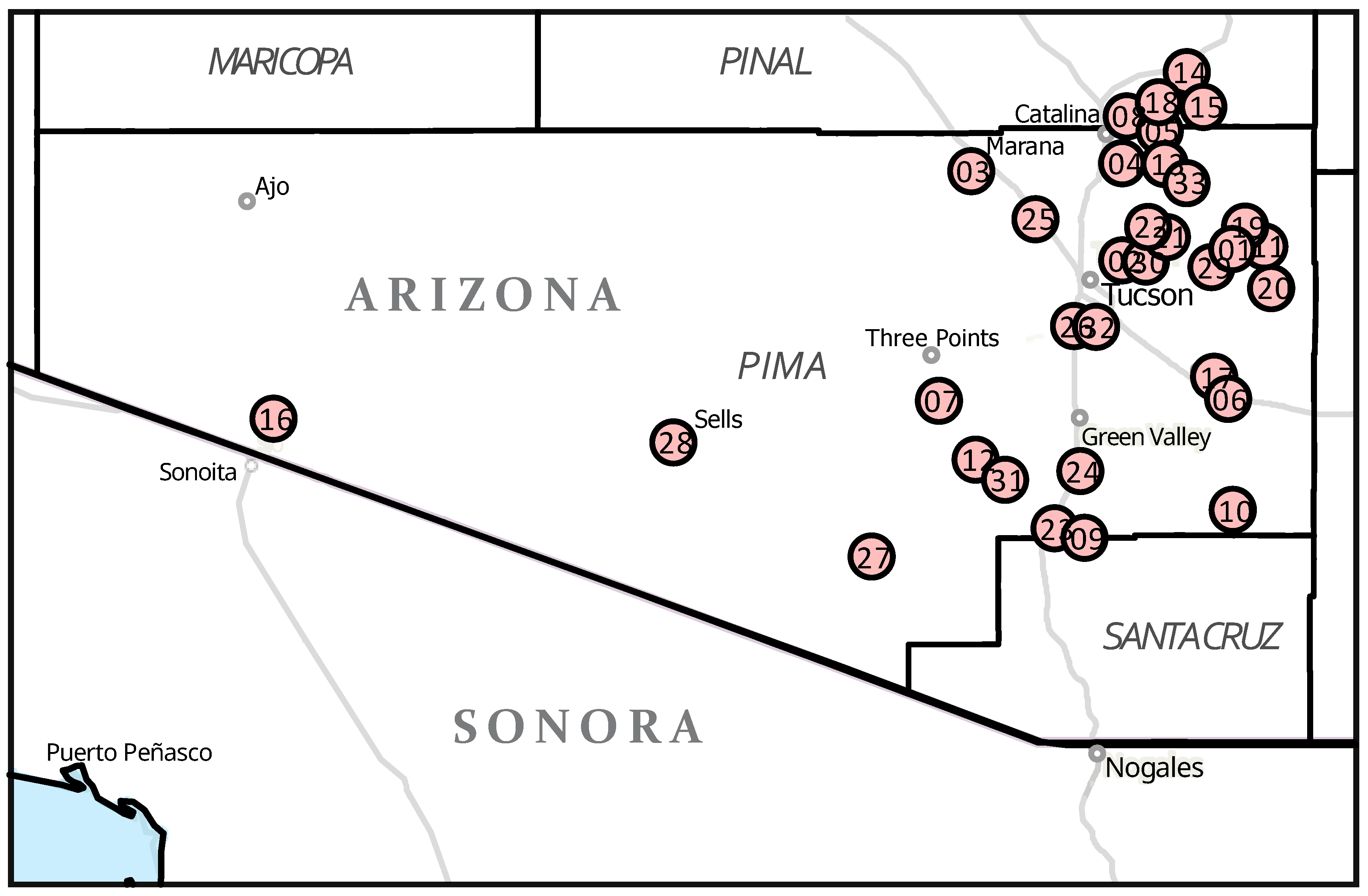
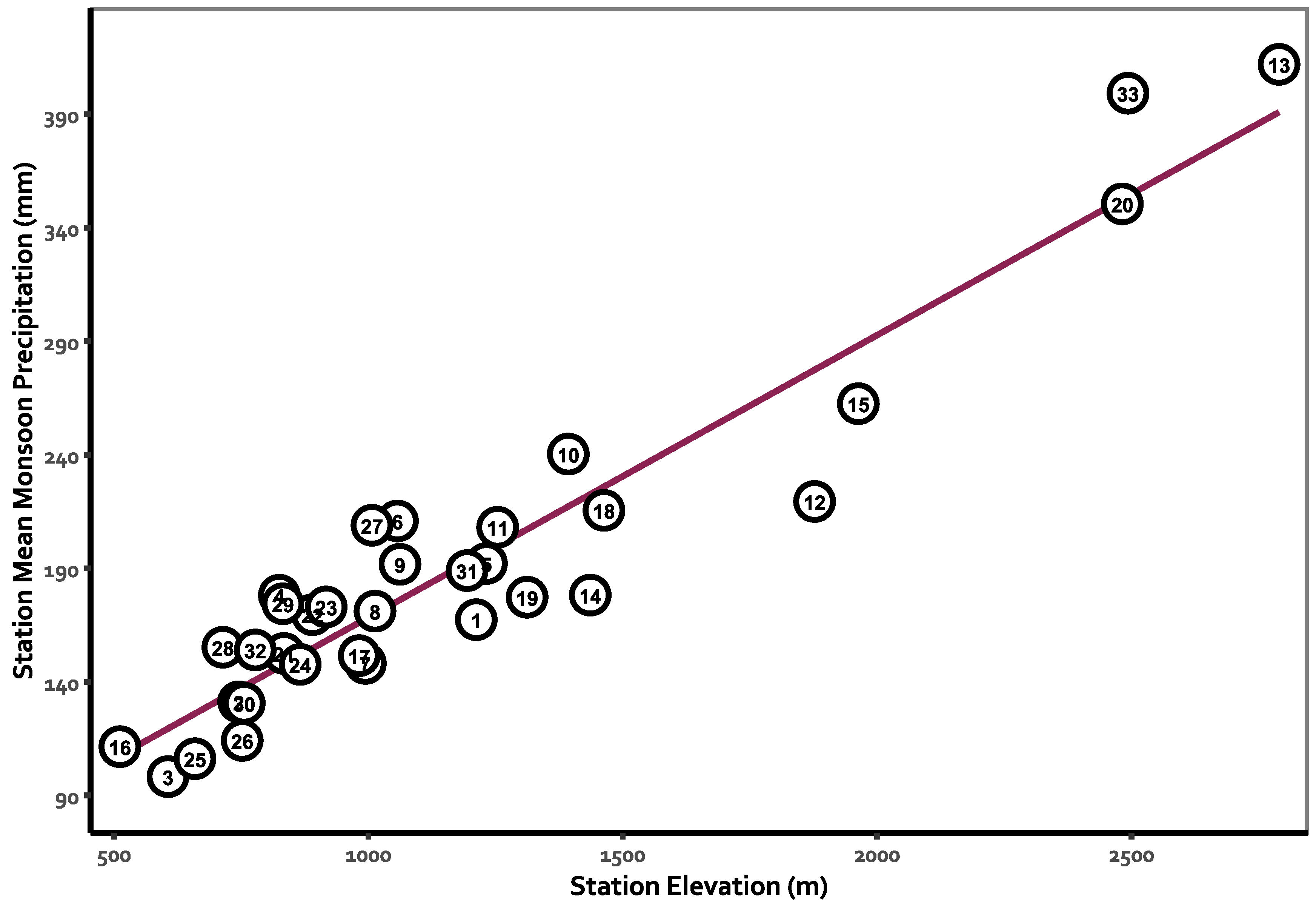
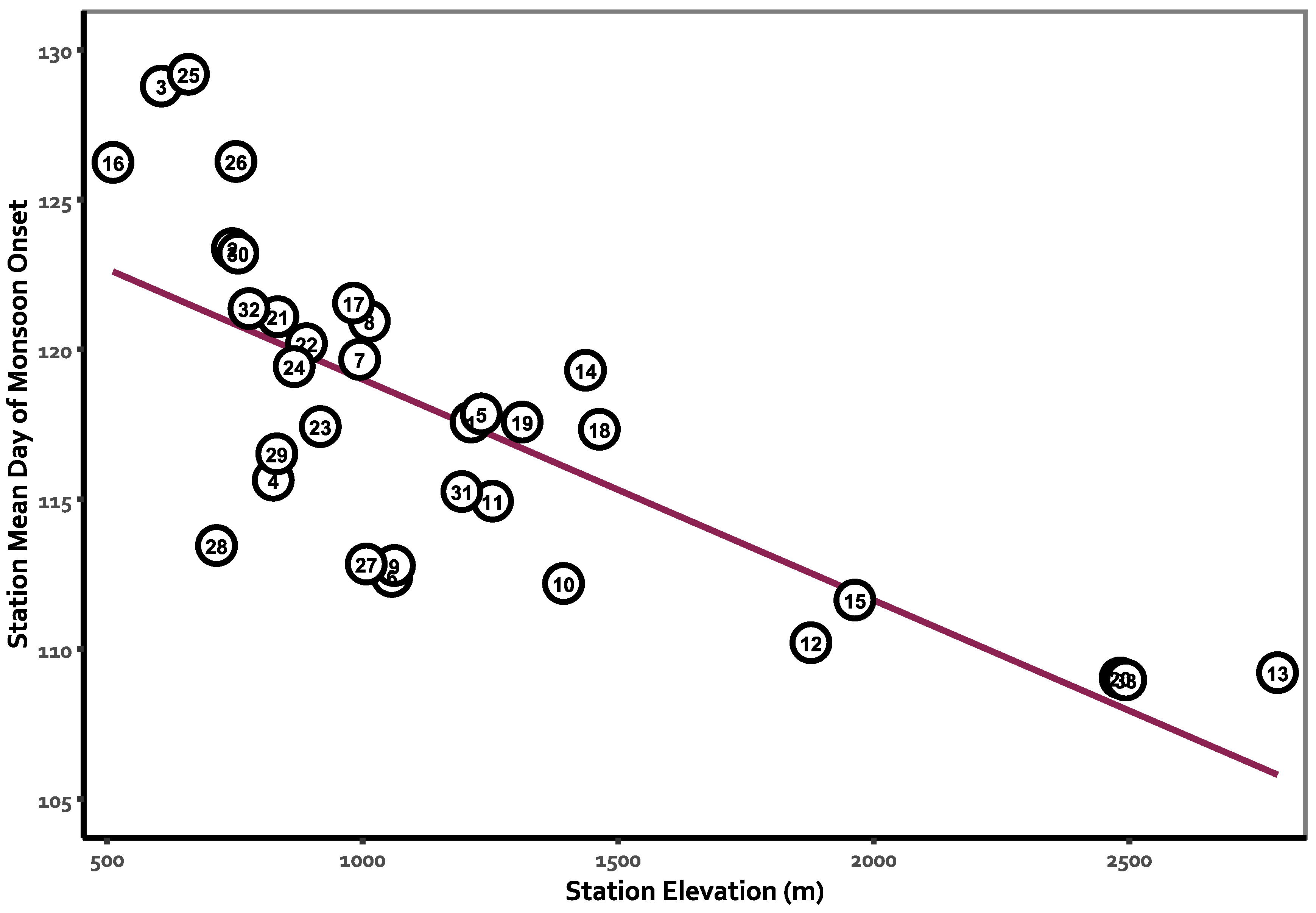
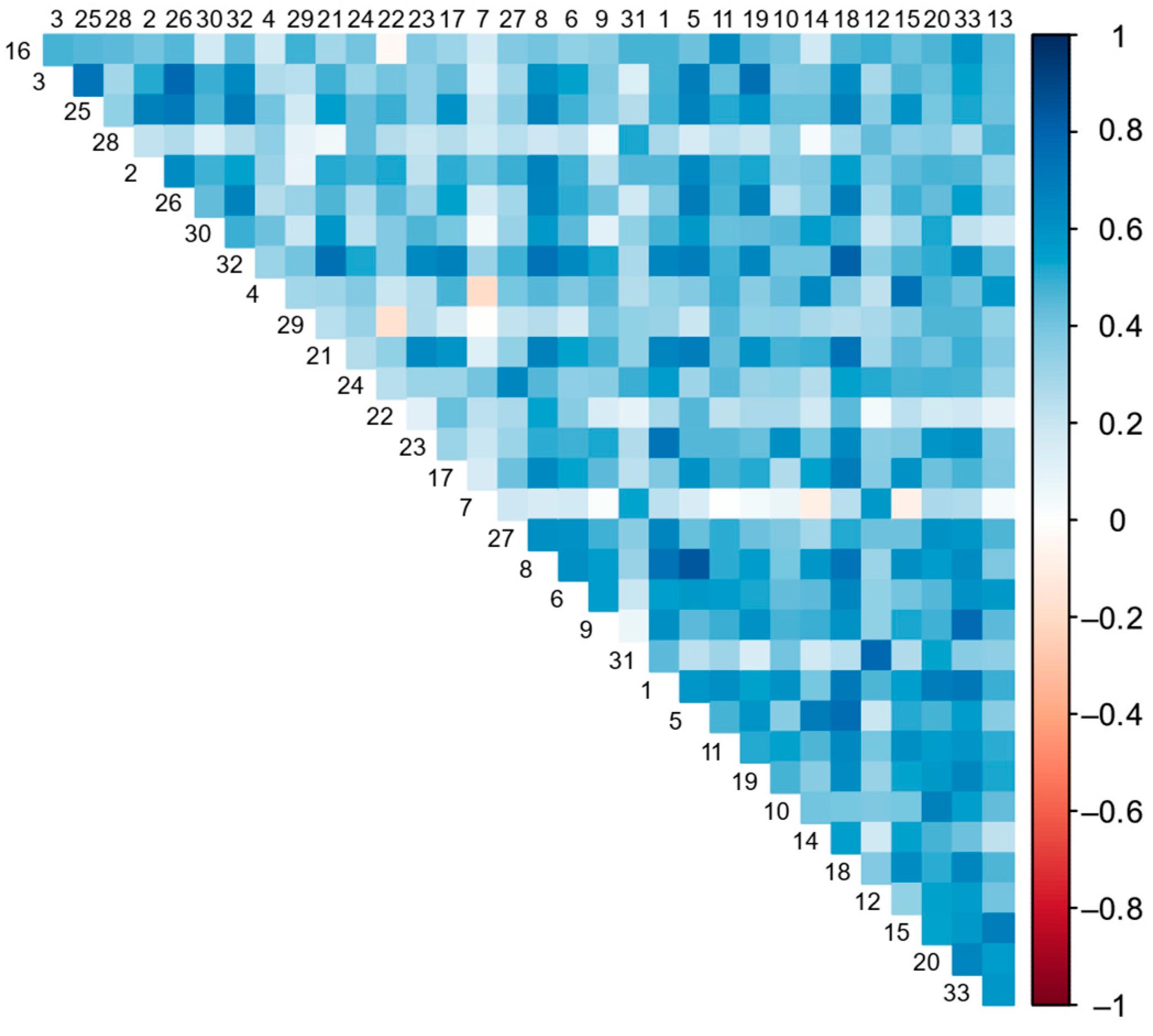
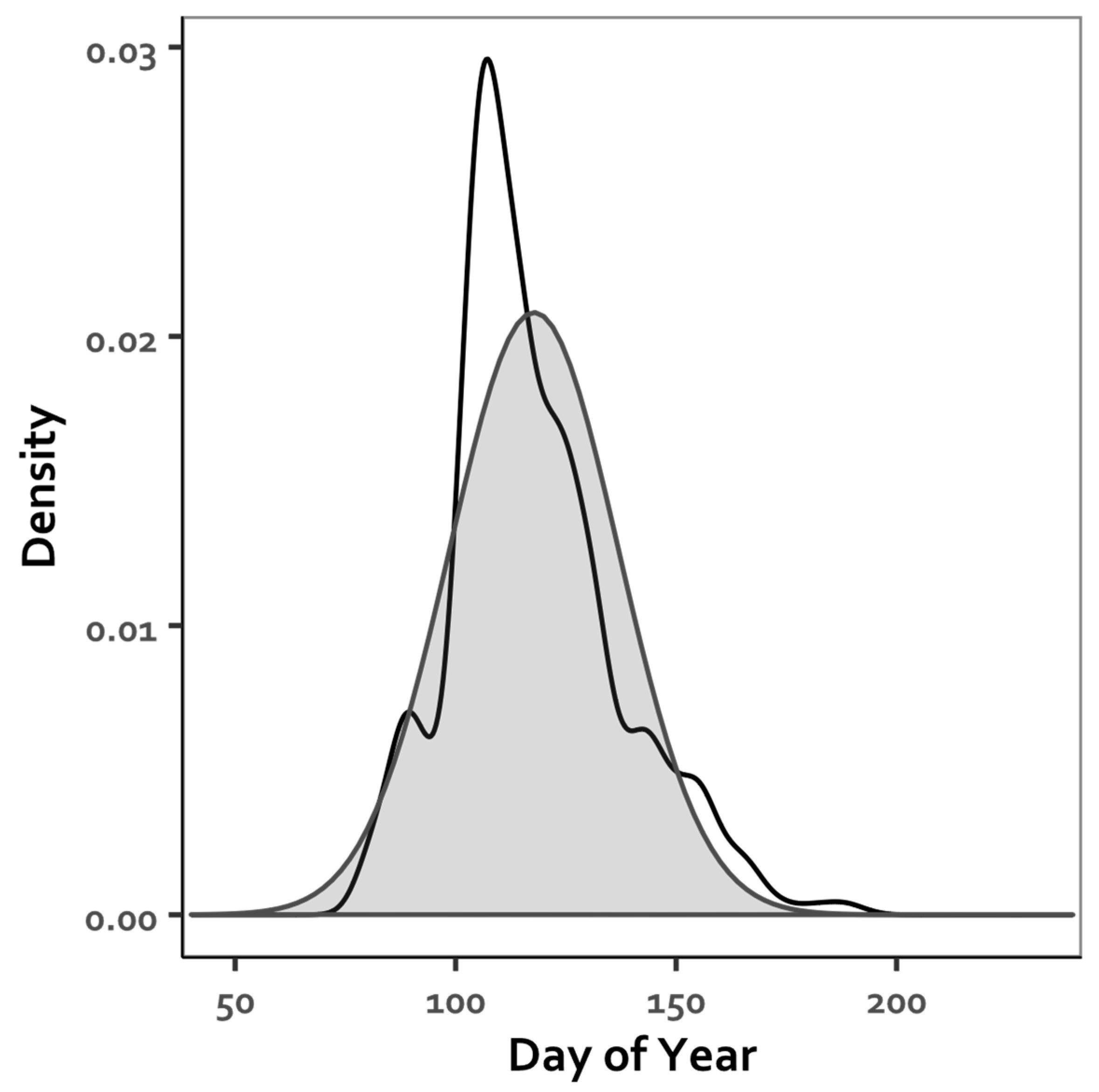
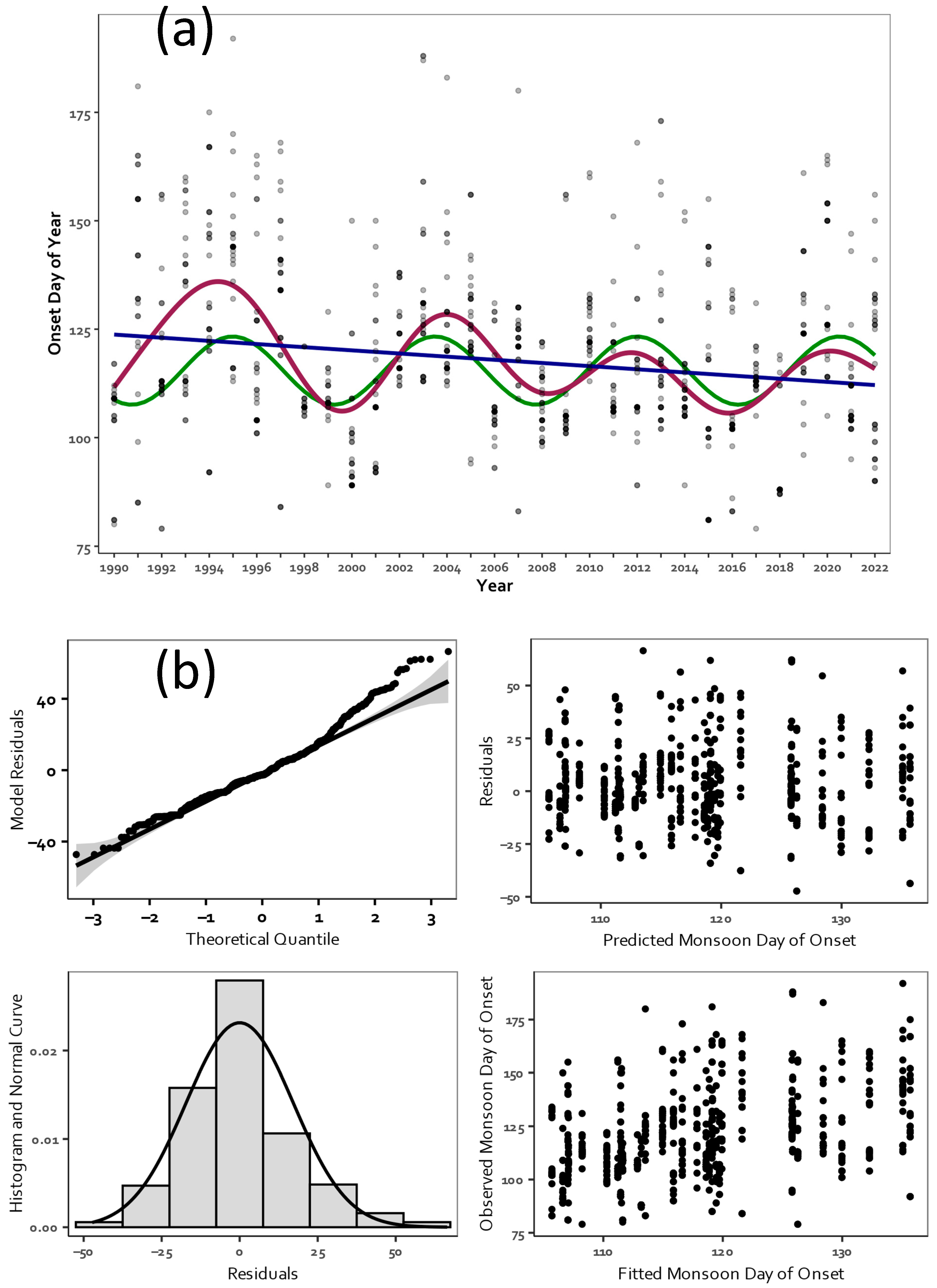

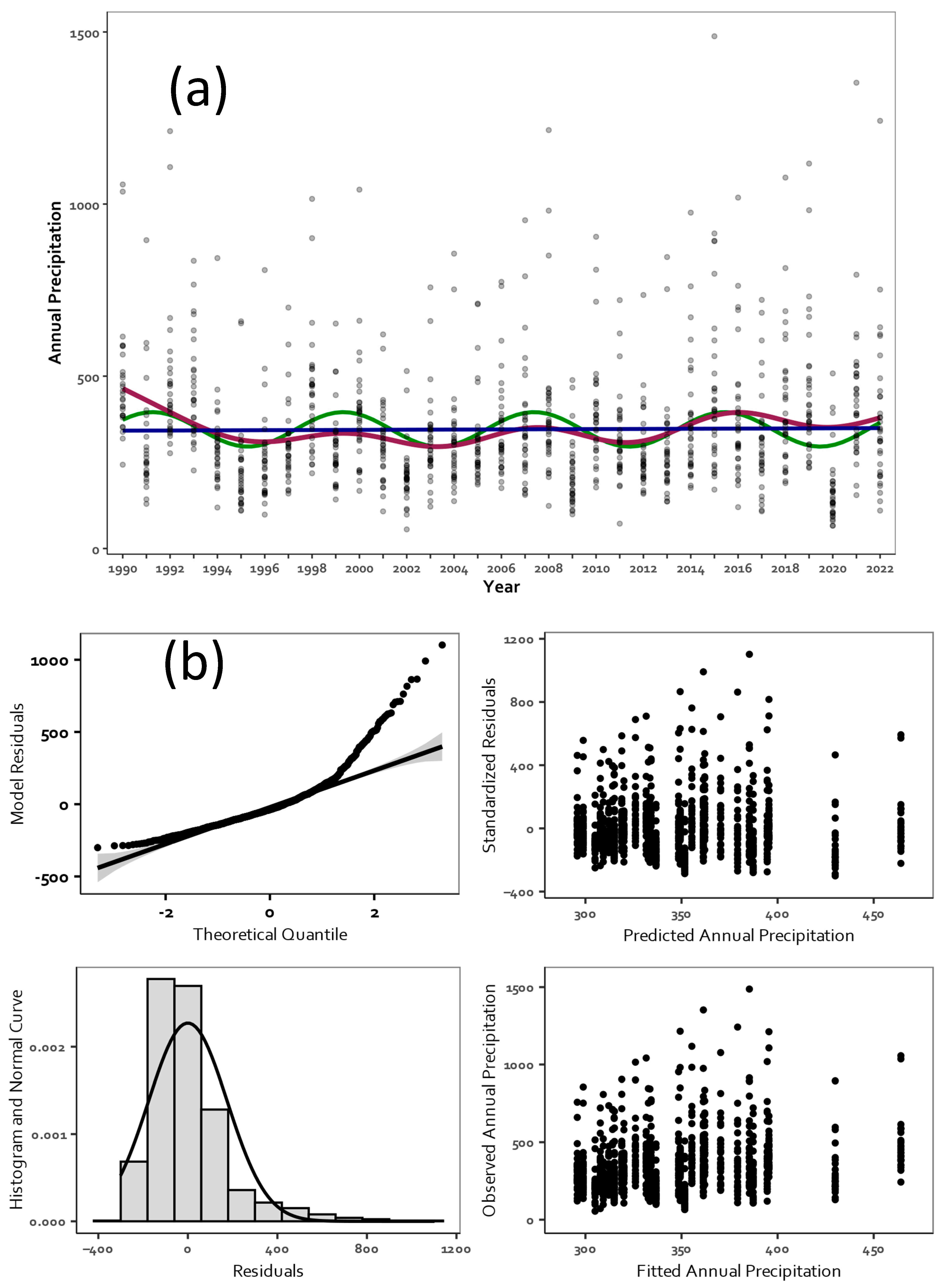

| Station Name | Station ID | Network | Period of Record Used | Elev. (m) | Latitude | Longitude | |
|---|---|---|---|---|---|---|---|
| 1 | Alamo Tank | 2080 | Pima Co. ALERT 1 | 1990–2022 | 1212 | 32.2797 | −110.6350 |
| 2 | Alamo Wash/Glenn St | 2370 | Pima Co. ALERT 1 | 1990–2022 | 745 | 32.2587 | −110.8841 |
| 3 | Avra Valley Air Park/Santa Cruz R | 6110 | Pima Co. ALERT 1 | 1990–2022 | 606 | 32.4290 | −111.2251 |
| 4 | Catalina State Park | 1070 | Pima Co. ALERT 1 | 1990–2022 | 825 | 32.4235 | −110.9161 |
| 5 | Cherry Tank | 1050 | Pima Co. ALERT 1 | 1990–2022 | 1232 | 32.5181 | −110.8370 |
| 6 | Davidson Canyon | 4310 | Pima Co. ALERT 1 | 1990–2022 | 1057 | 31.9936 | −110.6451 |
| 7 | Diamond Bell Ranch | 6410 | Pima Co. ALERT 1 | 1990–2022 | 994 | 31.9897 | −111.2972 |
| 8 | Dodge Tank | 1040 | Pima Co. ALERT 1 | 1990–2022 | 1013 | 32.5119 | −110.8642 |
| 9 | Elephant Head | 6350 | Pima Co. ALERT 1 | 1990–2022 | 1062 | 31.7250 | −110.9678 |
| 10 | Empire | 021205 | RAWS 3 | 1990–2016, 2018–2022 | 1393 | 31.7806 | −110.6347 |
| 11 | Italian Trap | 2030 | Pima Co. ALERT 1 | 1990, 1992–2022 | 1254 | 32.2853 | −110.5636 |
| 12 | Keystone Peak | 6310 | Pima Co. ALERT 1 | 1990–2022 | 1877 | 31.8769 | −111.2150 |
| 13 | Mount Lemmon | 1090 | Pima Co. ALERT 1 | 1990–2022 | 2790 | 32.4427 | −110.7885 |
| 14 | Oracle R.S. CDO | 1020 | Pima Co. ALERT 1 | 1990–2012 | 1436 | 32.5855 | −110.7868 |
| 15 | Oracle Ridge | 1030 | Pima Co. ALERT 1 | 1990–2022 | 1963 | 32.5328 | −110.7562 |
| 16 | Organ Pipe Cactus NM | USC00026132 | NCEI 2 | 1990–20022 | 512 | 31.9555 | −112.8002 |
| 17 | Pantano Vail | 4250 | Pima Co. ALERT 1 | 1990, 1992–2022 | 982 | 32.0361 | −110.6767 |
| 18 | Pig Springs | 1060 | Pima Co. ALERT 1 | 1990–2022 | 1463 | 32.5261 | −110.7948 |
| 19 | Ranch Rd | 2050 | Pima Co. ALERT 1 | 1990–2022 | 1312 | 32.3103 | −110.6061 |
| 20 | Rincon | 021207 | RAWS 3 | 1995–1999, 2002–2022 | 2482 | 32.2056 | −110.5481 |
| 21 | Sabino Dam | 2160 | Pima Co. ALERT 1 | 1991–2022 | 834 | 32.3147 | −110.8106 |
| 22 | Saguaro | 021202 | RAWS 3 | 2002–2022 | 890 | 32.3167 | −110.8133 |
| 23 | Santa Cruz R/Canoa Ranch | 6060 | Pima Co. ALERT 1 | 1990–2022 | 917 | 31.7447 | −111.0372 |
| 24 | Santa Cruz R/Continental Rd | 6050 | Pima Co. ALERT 1 | 1990–2021 | 866 | 31.8542 | −110.9792 |
| 25 | Santa Cruz R/Ina Rd | 6020 | Pima Co. ALERT 1 | 1990–2022 | 659 | 32.3372 | −111.0800 |
| 26 | Santa Cruz R/Valencia Rd | 6040 | Pima Co. ALERT 1 | 1990–2021 | 752 | 32.1342 | −110.9919 |
| 27 | Sasabe | 021206 | RAWS 3 | 1993–2022 | 1007 | 31.6908 | −111.4500 |
| 28 | Sells | 021209 | RAWS 3 | 1999–2006, 2008–2009, 2011–2022 | 714 | 31.9100 | −111.8975 |
| 29 | Tanque Verde Guest Ranch | 2090 | Pima Co. ALERT 1 | 1990–1992,1994–2022 | 832 | 32.2458 | −110.6827 |
| 30 | Tanque Verde Sabino Bridge | 2120 | Pima Co. ALERT 1 | 1990–2022 | 756 | 32.2653 | −110.8414 |
| 31 | Tinaja Ranch | 6320 | Pima Co. ALERT 1 | 1990, 1992, 1994–2022 | 1194 | 31.8381 | −111.1483 |
| 32 | Tucson Int’l Airport | USW00023160 | NCEI 2 | 1990–2022 | 778 | 32.1315 | −110.9564 |
| 33 | White Tail | 2150 | Pima Co. ALERT 1 | 1990–1992, 1994–2022 | 2493 | 32.4136 | −110.7319 |
| Station | DOY Onset | Monsoon Rainfall (MR, mm) | Annual Rainfall (AR, mm) | Monsoon Proportion of Annual Rainfall (PAR) | |
|---|---|---|---|---|---|
| 1 | Alamo Tank | 117.58 | 167.40 | 345.44 | 0.48 |
| 2 | Alamo Wash below Glenn St | 123.36 | 131.23 | 244.69 | 0.54 |
| 3 | Avra Valley Air Park—Santa Cruz Basin | 128.79 | 98.29 | 199.32 | 0.49 |
| 4 | Catalina State Park | 115.64 | 178.18 | 348.69 | 0.51 |
| 5 | Cherry Spring | 117.85 | 192.16 | 379.87 | 0.51 |
| 6 | Davidson Canyon | 112.42 | 210.89 | 360.39 | 0.59 |
| 7 | Diamond Bell | 119.67 | 148.17 | 249.32 | 0.59 |
| 8 | Dodge Tank | 120.94 | 171.17 | 343.37 | 0.50 |
| 9 | Elephant Head | 112.79 | 191.82 | 306.42 | 0.63 |
| 10 | Empire | 112.19 | 240.36 | 359.13 | 0.67 |
| 11 | Italian Trap | 114.94 | 208.11 | 393.66 | 0.53 |
| 12 | Keystone Peak | 110.21 | 219.48 | 328.28 | 0.67 |
| 13 | Mount Lemmon | 109.21 | 411.99 | 809.18 | 0.51 |
| 14 | Oracle Ranger Stn at Canada del Oro | 119.30 | 178.23 | 356.17 | 0.50 |
| 15 | Oracle Ridge | 111.64 | 262.55 | 480.58 | 0.55 |
| 16 | Organ Pipe Cactus NM | 126.24 | 111.49 | 234.81 | 0.47 |
| 17 | Pantano Vail | 121.55 | 151.58 | 244.53 | 0.62 |
| 18 | Pig Springs | 117.33 | 215.57 | 451.81 | 0.48 |
| 19 | Ranch Road | 117.58 | 177.29 | 360.22 | 0.49 |
| 20 | Rincon | 109.69 | 349.48 | 574.48 | 0.61 |
| 21 | Sabino Dam | 121.47 | 149.06 | 302.59 | 0.49 |
| 22 | Saguaro | 120.19 | 169.61 | 309.14 | 0.55 |
| 23 | Santa Cruz River at Canoa Ranch | 117.42 | 173.03 | 271.15 | 0.64 |
| 24 | Santa Cruz River at Continental Rd | 119.42 | 147.73 | 243.46 | 0.61 |
| 25 | Santa Cruz River at Ina Road | 129.18 | 106.19 | 204.48 | 0.52 |
| 26 | Santa Cruz River at Valencia Road | 126.27 | 114.23 | 208.66 | 0.55 |
| 27 | Sasabe | 112.40 | 210.67 | 334.04 | 0.63 |
| 28 | Sells | 113.45 | 155.26 | 251.99 | 0.62 |
| 29 | Tanque Verde Guest Ranch | 115.91 | 174.43 | 328.58 | 0.53 |
| 30 | Tanque Verde Sabino Bridge | 123.21 | 130.59 | 240.29 | 0.54 |
| 31 | Tinaja Ranch | 115.26 | 189.03 | 310.90 | 0.61 |
| 32 | Tucson Int’l Airport | 121.36 | 154.09 | 273.47 | 0.56 |
| 33 | White Tail | 108.97 | 399.27 | 758.54 | 0.53 |
| Grand Total/Mean | 117.78 | 1189.92 | 345.46 | 0.55 |
| Model/Test | Response | Statistic | Value | p-Value |
|---|---|---|---|---|
| GAM | DOY Onset | Deviance explained | 19.1% | |
| LRM | R2 | 0.032 | <0.001 | |
| SRM | R2 | 0.176 | <0.001 | |
| MK Trend | 0.511 | |||
| GAM | Monsoon Rainfall | Deviance explained | 13.3% | <0.001 |
| LRM | R2 | 0.022 | <0.001 | |
| SRM | R2 | 0.084 | ||
| MK Trend | 0.654 | |||
| GAM | Annual Rainfall | Deviance explained | 5.4% | <0.001 |
| LRM | R2 | <0.001 | 0.830 | |
| SRM | R2 | 0.038 | ||
| MK Trend | 0.861 | |||
| GAM | Monsoon Rainfall Proportion of Annual | Deviance explained | 21.4% | <0.001 |
| LRM | R2 | 0.025 | <0.001 | |
| SRM | R2 | 0.174 | ||
| MK Trend | 0.052 |
| Variable | Crest | Trough | Amplitude (Crest-Trough) | Period, Mean Crest->Crest |
|---|---|---|---|---|
| DOY onset | 09/05/1994 | 07/08/1999 | 30 days | 3140 days 8.6 years |
| 06/01/2004 | 28/03/2008 | 18 days | ||
| 05/10/2011 | 09/11/2015 | 14 days | ||
| 22/02/2020 | ||||
| MR | 06/07/1998 | 11/10/1993 | 97 mm | 3039 days 8.3 years |
| 17/12/2006 | 10/08/2002 | 82 mm | ||
| 25/02/2015 | 05/12/2010 | 90 mm | ||
| 29/12/2018 | 89.667 | |||
| AR | 06/05/1999 | 14/12/1995 | 39 mm | 3050 days 8.4 years |
| 15/07/2007 | 01/04/2003 | 44 mm | ||
| 18/01/2016/ | 01/04/2011 | 43 mm | ||
| 05/10/2019 | ||||
| PAR | 14/09/1998 | 03/11/1993 | 27 pct | 2969 days 8.1 years |
| 17/12/2006 | 10/08/2002/ | 23 pct | ||
| 17/12/2014 | 29/12/2010 | 24 pct | ||
| 29/12/2018 |
| Reference | Aim of Study | Onset Identifier(s) | Geography | |
|---|---|---|---|---|
| 1914 | Huntington [55] | Describe monsoon climate of Ariz., New Mex. | Change in wind direction from westerly to southerly. | Ariz., New Mex. |
| 1955 | Bryson and Lowry [56] | Map shift in dominant air masses signaling monsoon season. | Sharp changes in Raininess Index. | Ariz. |
| 1973 | Brenner [27] | Describe antecedent monsoon climate of Ariz., investigate possible GoC connection. | Changes in several surface observations. | Ariz. |
| 1993 | Douglas, et al. [57] | Describe synoptic climatology Mex., U.S. monsoon, identify moisture source(s). | Rainfall amounts and wind shifts. | Mex., SW U.S. |
| 1997 | Higgins, et al. [58] | Diagnose atmospheric conditions preceding monsoon onset. | Precip. index magnitude and duration, 0.5 mm day−1 for 3 days. | Ariz., western New Mex. |
| 1998 | Higgins, et al. [59] | Extend earlier work, diagnose variability of Mex.-U.S. summer precip. | Precip. index magnitude and duration, 0.5 mm day−1 for 3 days. | Ariz., western New Mex. |
| 1999 | Higgins, et al. [60] | Extend earlier work, identify factors influencing variability. | Varies by region; precip. index magnitude and duration, 0.5 mm day−1 for 3–5 days. | Ariz., western New Mex., SW Mex. |
| 2002 | Mitchell, et al. [61] | Onset and evolution of monsoon rainfall related to GOC SSTs. | Varies by region; precip. index magnitude and duration, 0.5 mm day−1 for 3–5 days. | GoC, Ariz., New Mex. |
| 2004 | Ellis, et al. [62] | Develop regional criteria for monsoon onset. | Mean daily dew-point threshold 12.2° or 12.8° for 3 days. | SW U.S. |
| 2007 | Grantz, et al. [63] | NAM timing, rainfall amount, large-scale trends drivers. | Percentile of monsoon precip. threshold. | Ariz., New Mex. |
| 2008 | Liebmann, et al. [53] | Monsoon onset dates Mex. and U.S. climatology variability, season length, rate, SST topography influences. | Anomalous rainfall accumulation. | Mex., SW U.S. |
| 2009 | Turrent and Cavazos [64] | Clarify monsoon forcing with land–sea thermal flux and influence on onset. | First 5-day period mean core region precip. >1 mm. | NW Mex. |
| 2011 | Crimmins, et al. [65] | Relate summer flowering onset to monsoon climatological events. | 3-day mean daily dewpoint threshold at TUS. | Finger Rock Canyon, Pima Co., Ariz. |
| 2012 | Arias, et al. [66] | Determine multidecadal variations in monsoon seasonality and strength. | Pentad after which the rain rate > than annual mean rain rate in six of eight preceding pentads and after which rain rate > than annual mean in six of eight pentads. | NW Mex. |
| 2015 | Arias, et al. [25] | Investigate climate dynamics influencing variability of NAM and SAM. | Pentad after which the rain rate > than annual mean rain rate in six of eight preceding pentads and after which rain rate > than annual mean in six of eight pentads. | North America, South America |
| 2017 | Meyer and Jin [54] | Correct regional and global models for projected future climate effects on monsoon dynamics. | First occurrence after 1 May with three consecutive days with at least 0.5 mm day−1. | SW U.S., Mex. |
| 2020 | García-Franco, et al. [67] | Introduce new onset identifier. | Wavelet transform (maximum sum of wavelet coefficients) on precip. time series. | Mex., India |
| 2021 | Fonseca-Hernandez, et al. [68] | Analyze mixing mechanisms responsible for temporal and spatial variations of GoC boundary layer during NAM onset. | First day first sequence of five consecutive days mean precip. rate = +/> 2 mm day−1. | NW Mex. |
| 2021 | Ashfaq, et al. [26] | Construct regional climate model of monsoon change with increased greenhouse gas forcing. | Pentad after minimum seasonality of precip. value, similar to Bombardi and Carvalho [69]. | Global monsoon domains |
| 2024 | Duan, et al. [70] | Identify and analyze NAM extreme events. | First 1 mm day−1 for 5 days after 1 June. | GoC and surrounding lands |
Disclaimer/Publisher’s Note: The statements, opinions and data contained in all publications are solely those of the individual author(s) and contributor(s) and not of MDPI and/or the editor(s). MDPI and/or the editor(s) disclaim responsibility for any injury to people or property resulting from any ideas, methods, instructions or products referred to in the content. |
© 2025 by the authors. Licensee MDPI, Basel, Switzerland. This article is an open access article distributed under the terms and conditions of the Creative Commons Attribution (CC BY) license (https://creativecommons.org/licenses/by/4.0/).
Share and Cite
Reichenbacher, F.W.; Peachey, W.D. Cyclic Interannual Variation in Monsoon Onset and Rainfall in South Central Arizona, USA. Climate 2025, 13, 75. https://doi.org/10.3390/cli13040075
Reichenbacher FW, Peachey WD. Cyclic Interannual Variation in Monsoon Onset and Rainfall in South Central Arizona, USA. Climate. 2025; 13(4):75. https://doi.org/10.3390/cli13040075
Chicago/Turabian StyleReichenbacher, Frank W., and William D. Peachey. 2025. "Cyclic Interannual Variation in Monsoon Onset and Rainfall in South Central Arizona, USA" Climate 13, no. 4: 75. https://doi.org/10.3390/cli13040075
APA StyleReichenbacher, F. W., & Peachey, W. D. (2025). Cyclic Interannual Variation in Monsoon Onset and Rainfall in South Central Arizona, USA. Climate, 13(4), 75. https://doi.org/10.3390/cli13040075






